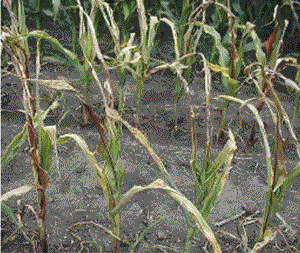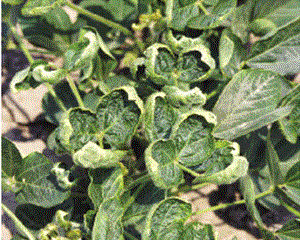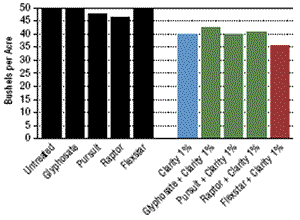More Isn't Always Better
content
 |
Aaron G. HagerAssistant Professor, Department of Crop SciencesPhone: (217) 333-4424 E-mail: hager@illinois.edu |
||
The widespread utilization of postemergence herbicides for weed control in corn and soybean production has greatly increased the options available to the farmer for eliminating weed interference before crop yields are adversely affected. Many postemergence herbicides offer numerous advantages over soil-applied products; especially significant is the advantage that the application (product selection, timing, rate, etc.) can be specifically tailored to the particular weeds present in the field. Application equipment has vastly improved over the past decade and applicators are now able to cover more acres per day than previously possible. When all the various "pieces" fall into place, postemergence weed control can be a very effective and profitable management tool.
A potential drawback to the widespread utilization of postemergence herbicide programs is the sometimes narrow window available in which to actually make the application. Environmental factors such as precipitation and wind often thwart the best attempts at making timely applications of postemergence herbicides. In addition to the potential for crop yield loss due to weed interference, delays in applying postemergence herbicides may result in other, less than desirable results. For example, if precipitation delays a postemergence application several days, when the soil becomes sufficiently dry the application may proceed even if prevailing wind speeds are too high for optimal results. In this scenario, drift is likely to happen.
Physical drift of a pesticide during the application process is a function of several factors, the most important of which is usually wind speed. Obviously, if enough of the postemergence herbicide is moved away from the intended target area because of high winds, poor weed control may result. Unfortunately, there are often additional consequences of herbicide drift, including potential damage to sensitive plants contacted by the drifted herbicide. Arguably, instances of herbicide drift have occurred for as long as synthetic herbicides (soil-applied and foliar-applied) have been used to control weeds in agronomic crops. However, not all herbicides elicit distinctive injury symptoms on the non-target plants with which they might come in contact via drift. For example, if bentazon drifts from a soybean field where it is being applied to an adjacent corn field, significant or long-lasting effects on the corn plants contacted by the bentazon are unlikely since corn is tolerant to bentazon. When certain selective or nonselective postemergence herbicides drift, however, the results of off-target movement may be much more noticeable, damaging, and persistent
Keep in mind, also, that physical drift is not the only avenue by which sensitive crop plants may come in contact with a herbicide not labeled for use in that sensitive crop. While application equipment has become larger and more technologically advanced, having longer booms and bigger tanks doesn't necessarily make cleaning the equipment any easier. Herbicide residues can "hide" in multiple locations within or on the application equipment that may not be easily accessible for cleaning purposes. These residues potentially can be dislodged when the equipment is used again, which may be in a crop that is extremely sensitive to that herbicide. While characteristic injury symptoms on a sensitive crop often follow a distinctive pattern from a contamination situation, these symptoms might not always stop where the booms were finally purged of the contaminate.
Many soybean farmers in Illinois and other states have adopted glyphosate for weed control in glyphosateresistant soybean varieties. However, a much smaller percentage have adopted the use of glyphosate in glyphosate-resistant corn hybrids. In other words, most of the Illinois corn crop remains sensitive to glyphosate. As a result of the greatly increased utilization of glyphosate for weed control, corn plants expressing injury symptoms characteristic of those caused by exposure to glyphosate (Figure 1) have become increasingly common in Illinois. Glyphosate is very effective on many annual grass species, including corn. It is not atypical that exposure to even small amounts of glyphosate can cause significant, but not necessarily lethal, damage to corn plants. In conjunction with the increased use of glyphosate for weed control and the increased occurrence of corn fields partially or completely affected by exposure to glyphosate has been the increased number of questions about how to interpret laboratory results that indicate some level of glyphosate has been detected in the damaged corn plants. In other words, samples of damaged corn plants are taken from the field, shipped off to a laboratory and analyzed for glyphosate, and a report is generated that indicates some level of glyphosate has been detected in the samples. The simple answer is that there is not always a simple and easy way to interpret these laboratory results.
Laboratory results are usually reported in parts per million (ppm) of glyphosate or one of its breakdown products (usually AMPA). At any given stage of corn growth and development, there exists a level of glyphosate at or above which is lethal to the plant. As the corn plant continues to develop, the critical level of glyphosate that causes plant death changes. So part of the problem with attempting to determine what effect a given level of glyphosate will have on the growth and development of the corn plant is that the effect will depend on the growth stage the corn plant was at when the exposure to glyphosate occurred. Additionally, laboratory results may vary depending on several factors, including part(s) of the corn plant sampled and analyzed, the amount of time that has elapsed between exposure and sampling, and the laboratory technique utilized to extract the glyphosate. In 2003 and 2004, researchers at the University of Illinois conducted an experiment where known amounts (rates) of glyphosate were applied to corn at various stages of development. Approximately two weeks after each application timing, several treated corn plants were harvested from each treatment, frozen, and then submitted to an analytical laboratory to quantify the amount of glyphosate found within the tissues of the plant. These results will provide some indication of what effect a given concentration of glyphosate may have on a corn plant at a specific stage of development.
However, while these results will be beneficial, other mitigating factors might influence the corn plants' ultimate response to a given level of glyphosate. For example, if the corn plant was exposed to glyphosate through contaminated application equipment, then it's very unlikely that glyphosate is the only herbicide to which the corn plant was exposed. In other words, exposure through contamination almost always results in at least two herbicides entering the corn plant: the glyphosate contaminate, and whatever herbicide was intentionally added to the spray tank. If selectivity of the "intended" corn herbicide is achieved via metabolism, then the corn plant must expend energy to accomplish this, possibly making the plant even more susceptible to glyphosate.
What about soybean? Abnormal soybean leaf development, often described as cupping or puckering, has been widely reported across Illinois and other Midwestern states during past growing seasons (Figure 2). The abnormal growth is most commonly found in soybean fields that received a postemergence herbicide application, but many reports have emanated from soybean fields in which no herbicide had been applied. The abnormal growth symptoms most often reported include: extreme cupping of trifoliolate leaves, usually most pronounced on the upper or youngest trifoliolates; veins of affected leaves tend to assume a parallel orientation instead of the usual net veination pattern; tips of cupped leaves with parallel veins are often brown; and overall, soybean plants are stunted compared with plants not demonstrating the aforementioned symptoms.
One of the most difficult challenges related to soybean leaf cupping is determining the cause or causal agent. Several theories have been proposed that attempt to explain the phenomenon of soybean leaf cupping. These include: the possibility that the abnormal growth is a physiological response of the soybean plant to adverse growing or environmental conditions; injury caused by a postemergence soybean herbicide might have disrupted the soybean plant's hormonal balance and resulted in the cupped leaves; or the soybean plant somehow has been exposed to one of the growth regulator (PGR) herbicides used primarily in corn. While the theories that adverse environmental conditions or disruption of the soybean plant's hormonal balance induce soybean leaf may sound plausible, they are not well supported by the scientific literature. However, the scientific literature is much more replete with evidence which describes the effects of plant growth regulator herbicides on soybean growth and development.
Identifying how a soybean plant has been exposed to a PGR herbicide may be readily apparent in many cases, but require a great deal of investigation in other instances. Three avenues of exposure include physical drift during the application, vapor drift within a few days following the application, and deposition of residues from application equipment directly onto the soybean plant during the application of a postemergence soybean herbicide (i.e., sprayer contamination).
Will yield loss occur if soybean leaf cupping symptoms occurred during the growing season? The simple answer is that any yield response is dependent upon several factors. Previous research has demonstrated, in general, that the likelihood of soybean yield loss increases: 1) when exposure to the PGR herbicide occurs closer to the time of soybean reproductive development (flowering or later), and 2) as the dose of the PGR herbicide increases. For example, a high-dose exposure during early vegetative development may not result in a yield loss, but exposure of the same or lower dose once flowering has commenced is more likely to cause soybean yield loss.
Previous research on soybean response to PGR herbicides examined the effects of exposure to only the PGR herbicide. However, with the contemporary practice of postemergence herbicide applications across the majority of soybean acres there exists a strong likelihood that if the soybeans are exposed to a PGR herbicide via residues dislodged from the application equipment they will also be exposed to the soybean herbicide being applied for weed control. It was previously unknown whether or not the presence of other herbicides would intensify PGR herbicide injury on soybean. Recently, weed scientists at the University of Illinois have investigated the effects on soybean yield when plants were exposed to growth regulator herbicides alone or in combination with postemergence soybean herbicides (Figure 3).
Tables & Figures
 |
Figure 1. Corn plants exposed to glyphosate. |
 |
Figure 2. Soybean leaf cupping caused by a plant growth regulator herbicide. |
 |
Figure 3. Soybean yield following herbicide
applications at V3 to glyphosate-resistant soybean. Soybean herbicides were applied at field use rates, while Clarity was applied at 1% of the field use rate for corn. |